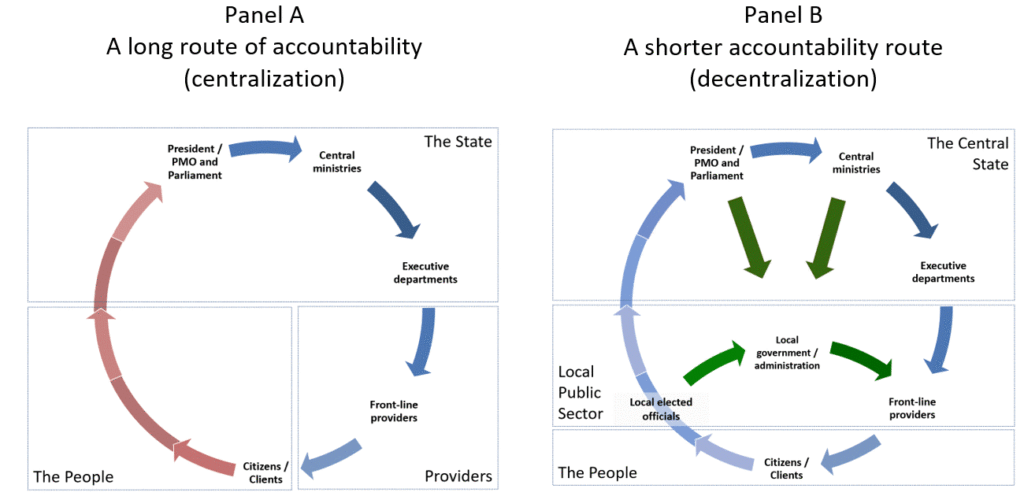Decentralization, the transfer of authority, responsibility and resources over public function from the central government to local governments or other local entities, is one of the most significant public sector reforms pursued by countries around the world.[1][2] Over the past 25 years, countries have pursued substantial decentralization reforms or reformed their intergovernmental fiscal architecture.
Like any intervention, there are pros and cons to decentralization as a public sector reform. While the specific impetus for pursuing decentralization reforms varies from country to country, the motivation behind decentralization reforms is often derived from one or more of the following four arguments:
- Efficiency. A major motivation for decentralization is that centralization is likely to be inefficient. While central government organizations often possess greater institutional capacity than local government organizations, centralization as a system provides a rather inefficient one-size-fits-all approach to policy making, taxation, and public service delivery. Under the right circumstances, decentralization can improve the allocative (and technical) efficiency of the public sector by tailoring policies, taxes, and the provision of public services more closely to the preferences and needs of residents in different regions and localities.
- Inclusiveness and responsiveness. Central government inefficiencies tend to be aggravated by the distance between the people and public sector decision-making, while decentralization tends brings the public sector closer to the people. In particular, the establishment or increased reliance on democratically elected local governments can enhance the effectiveness of the public sector as a mechanism for inclusive and responsive collective decision-making by shortening the “long” route of accountability between the public sector and its constituents (Figure 1.1).[3]
- Restructuring of political economy forces, especially in fragile and (post-)conflict contexts. Decentralization reforms involve changes in the vertical and horizontal distribution of power and resources and therefore have the potential to restructure the political economy dynamics of a country. While political economy considerations are relevant to decentralization reforms in every country, it is not uncommon for the restructuring of intergovernmental relations to be a specific aspect of peacebuilding and state-building in fragile and (post-)conflict countries. In these cases, decentralization reforms are pursued specifically to increase political competition and encourage political pluralism by creating subnational political space and by reducing the political monopolization of the public sector by a ruling party.[4]
- Sustainable development and improved public service delivery. In countries around the world, many of the pro-poor public services that are required to achieve sustainable global development – education, health services, access to clean water and sanitation, and others – are delivered at the local level. As such, sustainable development interventions and service delivery have important, but often overlooked, local and intergovernmental dimensions.
A caveat should be placed upfront in any discussion of decentralization and intergovernmental fiscal relations: while decentralization presents an opportunity to improve the efficiency of the public sector in a multilevel public sector context by moving public sector decision-making closer to the people, the reform in no way guarantees greater allocative and technical efficiency or greater accountability. Decentralization is not a panacea by itself. Capacity constraints, weak accountability relationships, and other public sector management challenges faced within the public sector are important factors that influence the outcome. At the same time, however, it is unlikely that the weak frontline performance of the public sector in any country, regardless of its public sector structure, can be resolved without acknowledging the important role of the country’s vertical or intergovernmental fiscal architecture and relations.
[1] Unless otherwise noted, when referring to government levels, this note will use the terms “local” and “subnational” interchangeably. When used in a more precise manner, local governments are often defined as governments at the lowest level(s) of the territorial-administrative hierarchy, whereas regional or state governments are frequently positioned as an intermediate territorial-administrative level.
[2] The term, “central government,” refers to the national government in a unitary country or to the federal government in a federal country. The distinguishing feature of a federal country (compared to a unitary country) is that in a federal system some of the powers or rights of subnational governments are protected in the Constitution or Basic Law in a way that cannot be unilaterally undone by the national government. Other than this distinction, all concepts and principles related to decentralization apply equally to federal and unitary countries.
[3] World Bank. 2004. WDR 2004: Making Services Work for Poor People.
[4] As noted further below, however, decentralization reforms are a pendulum. As such, intergovernmental systems can also be restructured in order to increase the vertical power of the national ruling party or the national government as a whole based on political or political economy considerations.



